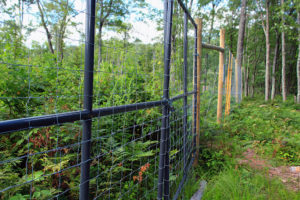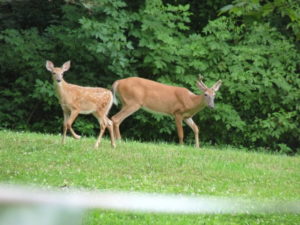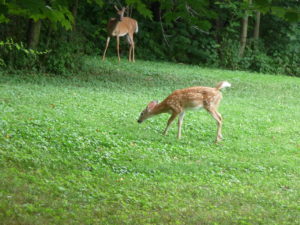White-tailed deer are both a charismatic species of our eastern forests and a major problem. The sight of a deer emerging from a stand of trees or brush is breathtakingly beautiful, but the damage they do to tree seedlings and forest understory plants (not to mention gardens, shrubs and ornamentals) is devastating. Some foresters, in fact, refer to white-tailed deer as “tree locusts,” and forest ecologists worry that the consequences of deer browsing on tree seedlings might include the disruption of forest succession and renewal throughout the northeast! Fern-lands and moor-lands could possibly replace our diverse hardwood forests if deer consume the next successional generation of trees!
In many of our state parks and game lands there are enclosures designed to prevent white-tail deer from browsing on tree seedlings and other understory plants. These “deer exclosures” have fences 8 or 10 feet tall, and the areas that they protect are typically filled with densely growing understory plants and large numbers of tree seedlings and saplings. The forest outside the fence barrier, though, often has a cleaned out, park-like appearance that is referred to as a “deer savannah” (see picture to the left). The impact of the deer is terribly clear! The deer are consuming tree seedlings and also many of the other ecologically important plants of the forest understory.
In 1900 it was estimated that there were only 500,000 white-tailed deer left in North America. Intense hunting pressures and massive deforestation through the Nineteenth Century had decimated their numbers and made them a species only rarely seen in our forests. The sighting of a deer, in fact, could make front page news in some of the rural newspapers of northwestern Pennsylvania! Today, however, there are estimated to be over 15,000,000 white-tailed deer in North America! Forest regeneration, elimination of natural predators, and strict hunting laws have allowed this species to reach population numbers and densities that far exceed those even of the pre-European settlement forest ecosystems!
A three year study conducted at the Penn State Deer Research Center (State College, PA) was recently published in the journal Biological Invasions. This paper examined the interactions between native and invasive plants and deer. In particular, the study was designed to determine which types of seven native and eight exotic plants were eaten by white-tailed deer. The plants were grown in containers that were then placed into a deer enclosure containing eight mature does. Cameras equipped with motion detectors monitored and recorded deer feeding behaviors, and at the end of the study period the amount of each plant that was consumed was determined.
Four plants were avoided by the deer. Three of these were exotic invasives (garlic mustard (Alliaria petiolata), Japanese barberry (Berberis thunbergii) and Japanese stiltgrass (Microstegium vimineum)), and one was a native (but frequently invasive) species (hay-scented fern (Dennstaedtia punctilobula)). All four of these plants are common invasives in our deer infested forests! This study clearly showed that their abundance in these ecosystems is due to their not being consumed by deer. Selective browsing by deer is contributing to the persistence and spread of these invasive plants!
Deborah and I noticed on our Baker Trail hikes six years ago that many native plants were avoided by deer in favor of introduced ornamental and garden species. We planted a native perennial garden in our field in an attempt to have some deer resistant flowering plants around our house. We especially planted bee balm (Monarda spp) and enjoyed its bright blossoms and the wonderful array of bees and hummingbirds it attracted! The “deer resistance” worked for about a year, but then the deer decimated all of the previously resistant species (especially the bee balm!). Deer are adaptable (and voracious!). We now hide the bee balm in our fenced-in yard!
A recent article in the New York Times (by James Gorman, July 18, 20166) discussed another aspect of the large, eastern U.S. white-tailed deer population: collisions with cars. Each year there are more the one million deer/car encounters, and two hundred people a year die as a result! Gorman’s article highlights some serious discussions among wildlife biologists (in the journal Conservation Letters) about a way to reduce deer populations and the subsequent number and staggering costs of deer/vehicle accidents. These wildlife biologists estimate that over thirty years the change that they have proposed could prevent 155 human deaths and 21,400 human injuries, and save $2.3 billion! The change is quite simple: re-introduce the eastern cougar to its original range throughout the East! These researchers estimate that a cougar would kill 259 deer over its six year life span, and that allowing cougars to return to their historical population densities would help to bring the exploding deer populations under control!
Of course there are a few downsides to having a large, active predator among us. Livestock would be attacked and eaten (estimated losses 2.35 million dollars a year), people would be attacked and even killed (estimated only one person per year would die of cougar inflicted injuries), and house pets would also be consumed by the cougars (the researchers, though, could not come up with a realistic estimate of the numbers of dogs and cats that would be eaten by the cougars). The researchers also acknowledged that the fear of being in a car crash doesn’t generate the same level of anxiety in most people as the possibility of being leaped upon by a lurking cougar. They recognize that their plan has a steep uphill climb to reach any level of public acceptance!
There is also the distinct possibility that adding cougars to the eastern U.S. fauna might not affect deer populations at all! The wildlife biologists acknowledge that 75% of the deer killed by cougars would probably have died due to some other fatal event, and that more fawns would be expected to be born if the number of adults were reduced. So, total deer population numbers might stay the same!
I don’t expect cougars to be widely re-introduced into our eastern forests. We do need, though, to be aware of the seriousness of our current deer problem! We can’t fence in a whole forest to prevent the browser hijacking of its natural regrowth and succession, but we need to find a way to find a new, functional balance to maintain our forest biomes!
Just a short note about the deer in my yard and field: we have, as I have written about many times before, a herd of deer that numbers 7 or 8 individuals. This year there are two older and three younger does (probably last year’s fawns) and two fawns. For the first time in six years, there are no twin fawns. The two older does have each had a single offspring. There is also a young buck that tries to join this loose group out. He is sporting short, simple looking antlers and may be the male sibling of one of the younger, yearling does. The fawns are very interested in the buck (see photo above!), and we have watched them approach him to sniff and even touch noses. Usually, though, the does chase the young buck away if he tries to get too close or too familiar.
The big attraction, right now, for the deer are the green apples that are falling from the trees in our orchard! The fawns especially like the sour, hard apples and are out under the old trees at almost any time during the day. There must be something incredibly addictive in the taste of these apples! Twisted up faces and violent head shaking while chewing them doesn’t seem to deter any of them from taking a second (and third, and fourth!) bite!






